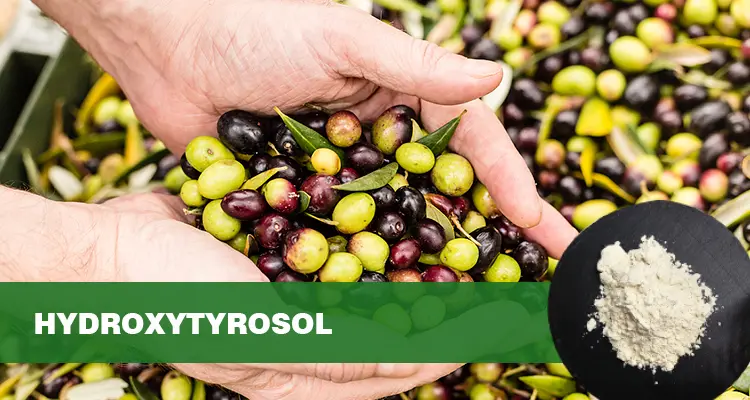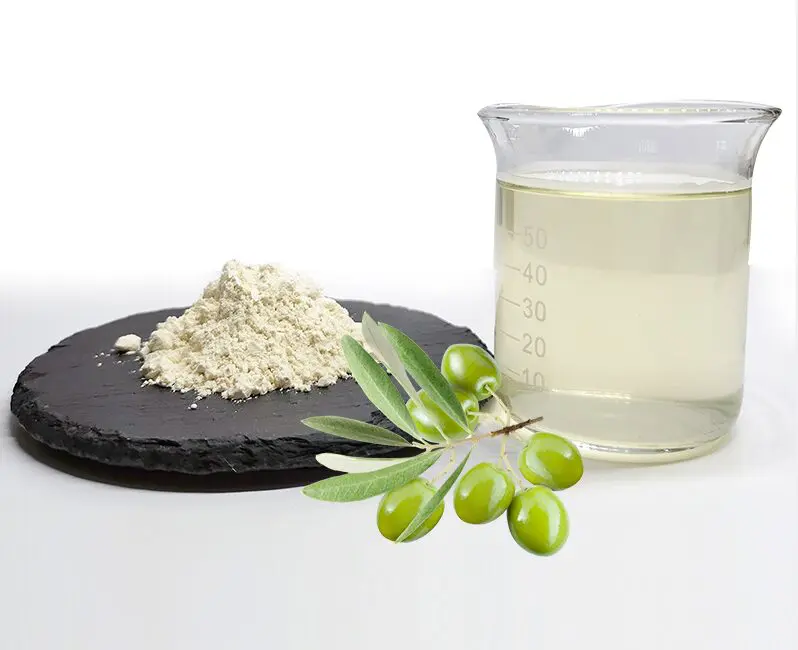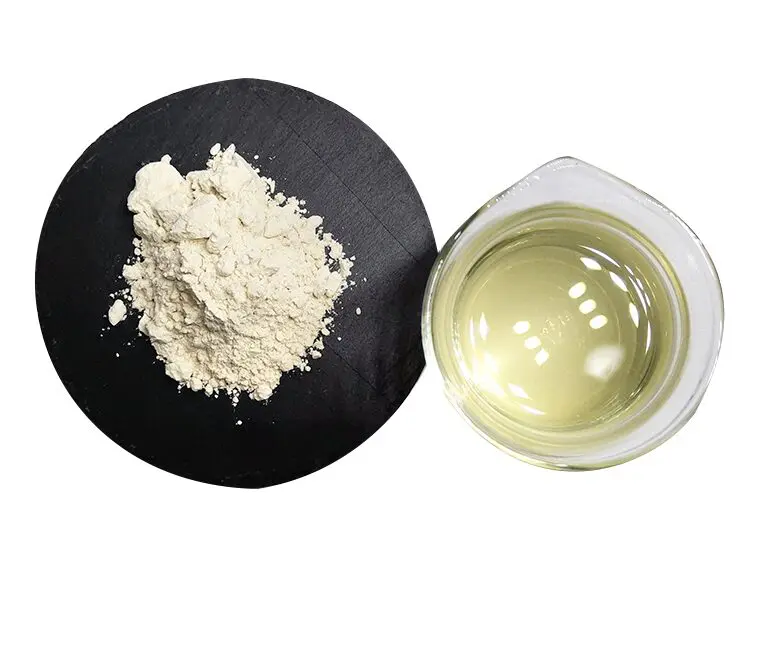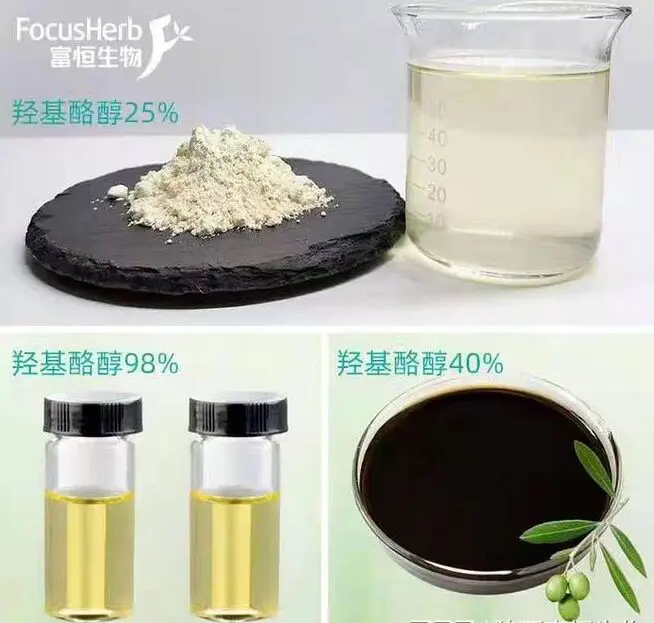Hydroxytyrosol is a natural phenolic compound found primarily in olive fruits and leaves. It is a key antioxidant in the Mediterranean diet. Due to the potent antioxidant capacity of the phenolic hydroxyl groups in its molecular structure, hydroxytyrosol effectively scavenges free radicals and protects cells from oxidative stress. Hydroxytyrosol has attracted significant attention in the health food and nutritional supplement sector for its diverse health benefits.
 The Core Mechanism of Hydroxytyrosol’s Skin-Brightening Effect
The Core Mechanism of Hydroxytyrosol’s Skin-Brightening Effect
(I) Targeted Inhibition of Tyrosinase, Blocking the Melanin Production Chain
Skin color is largely determined by the content and distribution of melanin. Tyrosinase, as the key rate-limiting enzyme in melanin synthesis, plays a crucial role in this process. When the skin is exposed to external stimuli such as ultraviolet light and inflammation, tyrosinase becomes activated, catalyzing the gradual oxidation of the substrate L-tyrosine to dopaquinone. This, in turn, undergoes a complex series of biochemical reactions to ultimately form melanin. Hydroxytyrosol, with its unique chemical structure, precisely binds to the copper ion at the active center of tyrosinase, effectively locking the enzyme’s work and preventing it from successfully catalyzing the key step of catalyzing the oxidation of dopa to dopaquinone.
Numerous rigorous in vitro studies provide strong evidence for this efficacy of hydroxytyrosol. In experimental conditions, a 0.5% hydroxytyrosol solution significantly inhibited tyrosinase activity by 40%-60%. In stark contrast, arbutin, a traditional whitening ingredient, inhibits tyrosinase activity by only 20%-30% at the same concentration. This clearly demonstrates that hydroxytyrosol possesses a significant advantage in inhibiting tyrosinase activity, effectively disrupting the melanin production pathway at its source. This effectively prevents the formation of dark spots and dull skin tone caused by excessive melanin production, laying the foundation for fair and translucent skin.
(II) Superior Antioxidant Capacity, Protecting Against Photoaging and Oxidative Darkening
In daily life, skin is constantly exposed to oxidative stress from multiple sources, including UV rays and environmental pollution. UV exposure stimulates molecules in the skin to produce large quantities of reactive oxygen species (ROS), such as superoxide anions and hydroxyl radicals. These ROS, like highly aggressive “little bombs,” can severely damage skin cells. They not only attack lipids in cell membranes, triggering lipid peroxidation and producing harmful products such as malondialdehyde (MDA), but also damage biomolecules such as proteins and DNA within cells, impacting normal cellular function. As a highly potent natural polyphenol antioxidant, hydroxytyrosol boasts astonishing antioxidant activity, 20 times that of vitamin C and 50 times that of vitamin E. This is primarily due to the catechol structure within its molecular structure, which acts as a powerful “free radical scavenger,” readily donating hydrogen atoms to bind to free radicals, converting them into stable species. This effectively scavenges UV-induced reactive oxygen species, such as superoxide anions and hydroxyl radicals, thereby terminating the oxidative chain reaction.
On the one hand, by reducing the production of lipid peroxidation products (such as MDA), it reduces the stimulation of these harmful substances on melanocytes, preventing them from over-synthesizing melanin. On the other hand, it acts as a guardian, protecting keratinocyte DNA from oxidative damage, maintaining normal cellular metabolism and physiological function, and preventing uneven skin tone and dullness caused by oxidative stress, keeping skin healthy and radiant.
(III) Dual Actions: Anti-Inflammation and Repair, Improving Inflammatory Skin Problems
Inflammation is a key factor in many skin problems. Common skin conditions such as acne and sensitive skin are often accompanied by inflammatory responses, which can further lead to skin blemishes. When skin inflammation occurs, inflammatory signaling pathways are activated in the body, with the NF-κB pathway playing a central role in regulating inflammation. This pathway triggers immune cells to release a series of pro-inflammatory cytokines, such as interleukin-6 (IL-6) and tumor necrosis factor-α (TNF-α). These cytokines cause capillary dilation, leading to redness, and stimulate melanocytes to overproduce melanin, resulting in post-inflammatory hyperpigmentation (PIH).
Hydroxytyrosol precisely regulates inflammatory signaling pathways. By inhibiting the activation of the NF-κB pathway, it reduces the release of pro-inflammatory cytokines such as IL-6 and TNF-α, thereby fundamentally alleviating the inflammatory response and reducing capillary dilation and redness. Clinical research data is surprising. Using skincare products containing 1% hydroxytyrosol for four weeks can reduce the area of post-inflammatory hyperpigmentation (PIH) by 30%-40%. This is because hydroxytyrosol not only has anti-inflammatory properties but also possesses remarkable repairing properties. It accelerates keratin metabolism, promoting the repair and regeneration of damaged epidermal cells, restoring the skin’s original smoothness and fine texture, while also improving translucency and leaving it radiant and radiant.
(IV) Promotes Collagen Synthesis, Improving Skin Transparency
With aging and environmental influences, collagen in the skin gradually depletes, contributing to a loss of elasticity and dull, rough skin. In the dermis, fibroblasts are responsible for synthesizing collagen. Hydroxytyrosol acts as a fibroblast “activator,” activating the ERK1/2 signaling pathway within fibroblasts, upregulating the expression of the type I collagen gene and promoting collagen synthesis.
Hydroxytyrosol also inhibits the activity of matrix metalloproteinases (MMP-1). MMP-1 is an enzyme that degrades collagen. When its activity is inhibited, collagen degradation slows, thereby maintaining the collagen content and structural stability in the dermis. Increasing collagen density in the dermis is crucial, injecting a “radiance factor” into the skin, enhancing light scattering within the skin and creating a translucent appearance from within. This improvement is particularly significant for mature skin, effectively addressing the dullness and roughness caused by collagen loss, restoring a youthful radiance and revealing a healthy, youthful texture.
Scientific Verification of Hydroxytyrosol’s Skin-Lightening Efficacy
(I) In Vitro Experiments and Animal Model Evidence
In the quest to explore the skin-lightening efficacy of hydroxytyrosol, rigorous scientific research is a key cornerstone. Researchers initially focused on in vitro experiments and animal model studies. Through these fundamental studies, they gradually unveiled the mysteries of hydroxytyrosol’s skin-lightening potential.
In experiments with melanocyte models, researchers utilized advanced experimental techniques to precisely add varying concentrations of hydroxytyrosol to the system and closely monitor its effects on the DOPA oxidation process. The results were encouraging: hydroxytyrosol exhibited significant concentration-dependent inhibition of DOPA oxidation, with an IC50 value (half-maximal inhibitory concentration) of 12.5 μM. This data clearly demonstrates that, under specific experimental conditions, a hydroxytyrosol concentration of 12.5 μM can inhibit DOPA oxidation by 50%. This inhibitory effect is significantly greater than that of traditional whitening ingredients. For example, arbutin’s IC50 value in the same experimental system typically ranges from 25 to 35 μM, further highlighting hydroxytyrosol’s potent ability to directly inhibit melanin synthesis and providing a solid theoretical basis for its application in skin whitening and brightening.
To more comprehensively validate hydroxytyrosol’s skin-lightening effects, researchers also employed a zebrafish photodamage model. Zebrafish, a commonly used model organism, exhibit photoaging and hyperpigmentation similar to human skin after exposure to ultraviolet light. In the experiment, the researchers divided the zebrafish into a control group and a hydroxytyrosol-pretreated group. Both groups were exposed to UV light, with the pretreated group receiving hydroxytyrosol before exposure. The results showed that melanin deposition in the hydroxytyrosol-pretreated group was significantly reduced compared to the control group, by 55%. This intuitively demonstrates that hydroxytyrosol effectively protects against UV-induced melanin production. The researchers also tested the activity of antioxidant enzymes in the epidermis of the two groups of zebrafish. Surprisingly, they found that the activity of epidermal antioxidant enzymes (such as superoxide dismutase (SOD) and catalase (CAT)) in the pretreatment group was 40% higher than in the control group. This suggests that hydroxytyrosol not only inhibits melanin production but also effectively mitigates UV-induced oxidative damage by enhancing the skin’s own antioxidant defense system. This demonstrates its synergistic anti-photoaging and whitening effects, providing stronger support for its use in skincare products.
(II) Human Clinical Research Progress
While in vitro experiments and animal model studies provide important theoretical support for the skin-lightening effects of hydroxytyrosol, definitive verification requires human clinical trials. In recent years, a growing number of research teams have devoted themselves to this field, conducting a series of carefully designed human clinical studies, providing more direct and reliable evidence for the application of hydroxytyrosol in skin-lightening.
In a short-term efficacy trial, researchers recruited volunteers to apply a serum containing 2% hydroxytyrosol twice daily for two weeks. Before and after the trial, volunteers underwent comprehensive skin testing using specialized skin testing equipment. The results showed that after just two weeks, the volunteers’ L value (a parameter for brightness) increased by an average of 8.7%, while the a value (a parameter for redness) decreased by 5.2%. The increase in L value indicates increased skin brightness, while the decrease in a value indicates decreased skin redness. These changes in both parameters directly reflect a significant improvement in skin tone uniformity. This result demonstrates that even in a relatively short period of time, hydroxytyrosol can rapidly work to achieve a noticeable brightening effect on the skin, resulting in a healthier, more luminous complexion.
In addition to short-term efficacy studies, long-term intervention studies are also attracting significant attention. In one eight-week study, participants took an oral cosmetic product containing 50mg of hydroxytyrosol daily. At the end of the eight-week intervention, facial spot area was measured using specialized image analysis software and revealed an average reduction of 22%. Furthermore, skin radiance scores, assessed by professional dermatologists, showed a 35% improvement. This demonstrates that long-term hydroxytyrosol consumption can sustainably exert its skin-lightening benefits, effectively reducing the formation of dark spots, enhancing skin radiance, and leaving skin appearing fairer and more translucent. Even more gratifying is that no adverse reactions were reported throughout the trial, fully demonstrating the safety and effectiveness of hydroxytyrosol in skin-lightening applications and laying a solid foundation for its widespread application in the beauty and healthcare fields.
 Hydroxytyrosol’s Diverse Applications for Skin Brightening
Hydroxytyrosol’s Diverse Applications for Skin Brightening
(I) Innovative Applications in Skincare Products
1. High-Concentration Essences
In the skincare market, high-concentration essences have long been a favorite for those seeking brighter skin due to their potent efficacy, and hydroxytyrosol has been particularly successful in this category. In formulation design, hydroxytyrosol is often combined with other star ingredients to create highly effective skin-brightening formulas. Among these, its combination with vitamin C derivatives (such as VC-IP) and ferulic acid is a classic. VC-IP is a stable and lipophilic vitamin C derivative that slowly releases active vitamin C into the skin, providing sustained antioxidant and whitening benefits. Ferulic acid, a natural plant-derived phenolic acid, not only possesses excellent antioxidant capacity on its own but also effectively stabilizes other antioxidant ingredients in the formula. When hydroxytyrosol is combined with VC-IP and ferulic acid, it forms a synergistic system that combines antioxidant activity, enzyme inhibition, and skin repair. For example, a high-end serum, meticulously formulated with a perfect ratio of 1.5% hydroxytyrosol to 0.5% ferulic acid, demonstrated remarkable skin-brightening results in rigorous testing by a third-party, authoritative testing agency. After 28 days of continuous use, volunteers experienced a significant improvement in skin brightness, a statistically significant improvement that strongly validated the effectiveness of the formula.
To maximize the effectiveness of hydroxytyrosol, researchers have also innovated in penetration technology. The use of liposome encapsulation is key to enhancing hydroxytyrosol’s transdermal absorption. Liposomes are tiny vesicles composed of amphiphilic substances such as phospholipids. Their structure is similar to that of cell membranes, resulting in excellent biocompatibility. Hydroxytyrosol is encapsulated within liposomes through a specialized preparation process, reducing its particle size to 50-100 nm. This tiny particle size allows hydroxytyrosol to more easily penetrate the stratum corneum, reaching the dermis and interacting closely with skin cells, thereby exerting its powerful skin-brightening effects. Experimental data shows that after being encapsulated in liposomes, hydroxytyrosol’s transdermal absorption rate increases threefold, providing more effective skin brightening care.
2. Gentle Whitening Masks
For those with sensitive skin, the pursuit of whitening often requires caution. The emergence of gentle whitening masks offers a welcome boost. In these masks, hydroxytyrosol works in conjunction with ingredients like allantoin and hyaluronic acid to inhibit melanin production while also soothing and moisturizing the skin, allowing even those with sensitive skin to safely enjoy the whitening process.
Allantoin has excellent soothing properties and promotes cell repair. It can effectively alleviate any discomfort that may occur during the whitening process and reduce skin sensitivity. Hyaluronic acid, the skin’s natural moisturizing factor, absorbs and locks in moisture, keeping the skin hydrated and plump. The combination of hydroxytyrosol, allantoin, and hyaluronic acid creates a gentle whitening environment for sensitive skin. A highly acclaimed facial mask is formulated with 0.8% hydroxytyrosol and 1% ceramide. Clinically tested, this mask demonstrated excellent results, effectively reducing irritation during the whitening process by 25%. This data demonstrates that the mask delivers whitening benefits while minimizing irritation to sensitive skin, allowing even those with sensitive skin to use it with confidence and enjoy the surprising transformation of gradually brighter, more translucent skin.
(II) Emerging Trends in Oral Beauty Products
1. Natural Botanical Complex Formulas
In their pursuit of beauty, people are increasingly prioritizing inner care, leading to the rise of oral beauty products. Natural botanical complex formulas have proven popular among consumers for their natural, safe, and effective properties. Tracel Brightening Drink is a leader in this field. It utilizes boysenberries as its core ingredient, combined with a variety of natural botanical extracts, to provide comprehensive care for brightening skin.
Growing in the pristine natural environment of New Zealand, boysenberries are a super berry rich in active ingredients. It not only contains a natural hydroxytyrosol precursor but is also rich in antioxidants such as anthocyanins and ellagic acid. These ingredients work synergistically to effectively inhibit tyrosinase activity and block the melanin production pathway. Furthermore, the active ingredients in boysenberries accelerate keratinocyte turnover, helping the skin excrete dead skin cells containing melanin, resulting in a naturally radiant complexion.
In addition to boysenberries, Tracel Whitening Drink also incorporates white crystal tomatoes and emblica fruit. White crystal tomatoes are rich in phytoene, a potent antioxidant that effectively protects the skin from UV damage and reduces the production of free radicals, thereby inhibiting melanin production at the source. Emblica fruit is a naturally high-concentration vitamin C fruit, containing 20 times more than lemons. Vitamin C not only inhibits tyrosinase activity and reduces melanin production, but also promotes collagen synthesis, enhancing skin’s elasticity and radiance. Through a three-dimensional pathway of “inhibiting enzyme activity – scavenging free radicals – accelerating metabolism,” Tracel Brightening Drink achieves a brighter complexion all over the body. Clinical data shows that after four weeks of continuous consumption, users experienced a significant reduction in dark spots in areas like elbows and knees, with a reduction of 20%-30%. These areas are prone to melanin accumulation, and with the treatment of Tracel Brightening Drink, the skin in these areas gradually becomes brighter and more translucent, significantly improving the overall skin texture.
2. Precision-Targeted Dietary Supplements
With the continuous advancement of technology, oral beauty products are also constantly innovating, giving rise to precision-targeted dietary supplements. FineNutri Photon Bottle is a representative example of this type of product. It utilizes a golden combination of “ergothioneine + hydroxytyrosol + SOD yeast” to provide comprehensive endogenous protection for the skin, effectively enhancing its ability to resist UV rays and pollution. It is particularly suitable for those exposed to long-term urban photoaging. Ergothioneine is a naturally occurring antioxidant found in human cells. It possesses unique physiological activity, effectively neutralizing free radicals and protecting cells from oxidative damage. It also regulates the intracellular redox state, enhancing the cell’s antioxidant defense system. Each bottle of the Fitzgerald Photon Bottle contains 10mg of ergothioneine, providing powerful antioxidant support for the skin.
Hydroxytyrosol, one of the core ingredients in the Fitzgerald Photon Bottle, has been previously described for its potent antioxidant, anti-inflammatory, and tyrosinase inhibitory properties. In this product, 50mg of hydroxytyrosol works synergistically with ergothioneine to further enhance the product’s antioxidant capacity, effectively reducing skin damage from UV rays and environmental pollution, preventing the formation of dark spots, and maintaining fair and translucent skin.
SOD Yeast is a yeast extract rich in superoxide dismutase (SOD). SOD is a widely present antioxidant enzyme in living organisms that catalyzes the dismutation of superoxide anion radicals, converting them into oxygen and hydrogen peroxide, effectively scavenging free radicals in the body. The addition of SOD yeast to the Feicui Photon Bottle provides additional antioxidant protection for the skin, boosting its own antioxidant capacity.
Cellular experiments have confirmed that the golden combination in the Feicui Photon Bottle significantly increases the activity of the Nrf2 antioxidant pathway by up to 60%. The Nrf2 antioxidant pathway is one of the key antioxidant defense mechanisms within cells. When activated, the expression of antioxidant enzymes (such as SOD and CAT) increases, thereby enhancing the cell’s antioxidant capacity. By activating the Nrf2 pathway, the Feicui Photon Bottle enhances the skin’s antioxidant capacity endogenously, allowing it to better defend against UV rays and pollution. This delivers truly targeted skin brightening, providing an effective skin protection solution for those exposed to urban photoaging.
Development Prospects and Challenges of the Hydroxytyrosol Skin-Lightening Market
(I) Industry Trends and Consumer Insights
1. Natural and Safe Approach
In today’s beauty market, the “Clean Beauty” concept is rapidly gaining popularity and becoming a key consideration for consumers when choosing products. This concept emphasizes the natural origins, pure formulas, and environmental friendliness of products, pursuing an additive-free, low-irritation skincare experience. Hydroxytyrosol, a natural ingredient extracted from olives, perfectly aligns with this trend.
Consumers’ demand for whitening products is no longer limited to rapid results; they are increasingly concerned with product safety and naturalness. They are eager to find products that effectively brighten their complexion without causing any harm to the skin. The emergence of hydroxytyrosol perfectly meets this market demand. Derived from olives, it is a precious gift from nature, and its natural properties provide consumers with greater peace of mind in their pursuit of whitening.
According to professional market research institutions, the global market for whitening skincare products containing hydroxytyrosol is expected to achieve a compound annual growth rate of 18% from 2023 to 2028. This data clearly demonstrates the strong market demand and confidence in hydroxytyrosol-based whitening products. Numerous well-known brands have launched whitening products containing hydroxytyrosol, which have been enthusiastically received by consumers. These products not only demonstrate excellent efficacy, but also highlight the natural origin of hydroxytyrosol in their ingredient promotions, allowing consumers to experience the care of nature during use.
2. Targeted Targeted Demand
As consumer skincare needs become increasingly diverse and sophisticated, the market demand for whitening products is moving beyond simply brightening the complexion. From basic brightening needs to integrated anti-aging and whitening benefits, consumers desire products that meet the differentiated needs of different skin types and age groups.
To meet this market demand, hydroxytyrosol is evolving from a single ingredient to a “hydroxytyrosol + X” combination system. For example, hydroxytyrosol is being combined with hydroxytyrosol. Hypocretin stimulates collagen production and enhances skin elasticity. Combined with the brightening properties of hydroxytyrosol, hydroxytyrosol achieves dual whitening and anti-aging benefits, making it particularly suitable for mature skin. For example, combining hydroxytyrosol with astaxanthin, which has powerful antioxidant properties, can further enhance the antioxidant effects of hydroxytyrosol while also effectively protecting against UV damage. This combination is particularly suitable for young skin types seeking daily sun protection and whitening.
Through this innovative combination, hydroxytyrosol can better meet the personalized needs of different consumers, providing comprehensive skin care. Whether you have oily, dry, or sensitive skin, you can find a whitening product containing hydroxytyrosol that suits you, achieving brighter and healthier skin.
(II) Technical Bottlenecks and Breakthrough Directions
1. Improving Bioavailability
Although hydroxytyrosol has shown great potential in the skin-lightening field, its application still faces several technical challenges. Among these, poor water solubility is a particularly prominent issue, with a solubility of less than 0.1 g/L. This characteristic significantly limits its use in aqueous solutions. Aqueous solutions, such as toners and serums, have always been a popular category in the skincare market due to their refreshing texture and good skin absorption. However, hydroxytyrosol’s low water solubility makes it difficult to disperse evenly in these products, thus hindering its effectiveness.
To address this issue, researchers are focusing on the development of technologies such as nanoemulsions and cyclodextrin inclusion. A nanoemulsion is a thermodynamically and kinetically stable, transparent or translucent system consisting of an aqueous phase, an oil phase, a surfactant, and a co-surfactant in appropriate proportions, with particle sizes ranging from 10 to 100 nm. Encapsulating hydroxytyrosol in a nanoemulsion significantly improves its water solubility and stability, enabling its application in aqueous solutions. Nanoemulsions also exhibit excellent transdermal absorption, promoting faster absorption and enhancing its skin-lightening effects.
Cyclodextrin inclusion is also an important means of improving the bioavailability of hydroxytyrosol. Cyclodextrin molecules have a unique ring structure with a hydrophobic interior and hydrophilic groups on the exterior. Encapsulating hydroxytyrosol within the cyclodextrin cavity forms a stable inclusion complex, improving its water solubility and stability. Research has shown that the hydroxytyrosol-β-cyclodextrin inclusion complex prepared using a saturated aqueous solution method achieves optimal inclusion efficiency when maintained at a constant temperature of 50°C, with a hydroxytyrosol volume to β-cyclodextrin mass ratio of 1:6, stirred for 1 hour, and a stirring speed of 1200 rpm. This effectively improves the stability and bioavailability of hydroxytyrosol. The development and application of these technologies will provide strong support for the widespread use of hydroxytyrosol in skin lightening applications.
2. Standardization of Efficacy Evaluation
Establishing a scientific and comprehensive efficacy evaluation system is crucial for the development and promotion of hydroxytyrosol skin lightening products. Currently, numerous methods exist for evaluating skin lightening efficacy, but a lack of unified standards. This creates confusion for consumers when choosing products and is detrimental to the healthy development of the industry.
To achieve standardized efficacy evaluation, a multi-dimensional evaluation system based on skin color analyzers (such as Chromameter) and VISIA skin testing is necessary. A skin color analyzer can accurately measure skin color parameters such as L value (brightness), a value (redness), and b value (yellowness). By monitoring these parameters, changes in skin brightness and color can be intuitively understood. The VISIA skin analyzer offers even more powerful capabilities. Using specialized camera technology and software analysis, it can comprehensively assess skin pigmentation, wrinkles, pore size, sebum secretion, and other aspects. When evaluating hydroxytyrosol-based skin-lightening products, the VISIA skin analyzer can be used to analyze skin before and after use, comparing and analyzing the improvement in pigmentation and accurately assessing the product’s skin-lightening effectiveness.
In addition to traditional skin testing methods, combining genetic testing (such as MC1R genotype) to customize skin-lightening solutions is also a future development. The MC1R gene is closely related to skin pigmentation, and different MC1R genotypes can lead to differences in individual sensitivity to UV rays and melanin production. By testing an individual’s MC1R genotype, we can understand the pigment metabolism characteristics of their skin, thereby tailoring a personalized skin lightening plan for them, selecting the most suitable hydroxytyrosol product and usage method, and achieving more accurate and efficient skin lightening effects.
Hydroxytyrosol, with its multi-target mechanism of action and natural safety, is becoming a versatile player in the skin lightening market. From precisely targeting melanin production inhibition to providing comprehensive antioxidant, anti-inflammatory, and repairing benefits, its scientific value and potential have been widely validated. With continued breakthroughs in delivery technology and formulation innovation, hydroxytyrosol is poised to lead the new trend of “healthy skin lightening,” bringing consumers a naturally radiant glow that shines through from the inside out.



















 The Core Mechanism of Hydroxytyrosol’s Skin-Brightening Effect
The Core Mechanism of Hydroxytyrosol’s Skin-Brightening Effect
 Hydroxytyrosol’s Diverse Applications for Skin Brightening
Hydroxytyrosol’s Diverse Applications for Skin Brightening